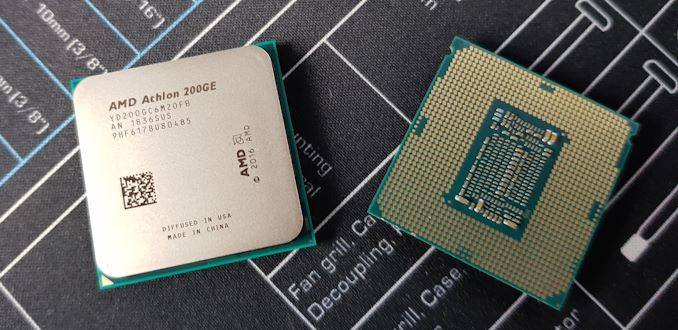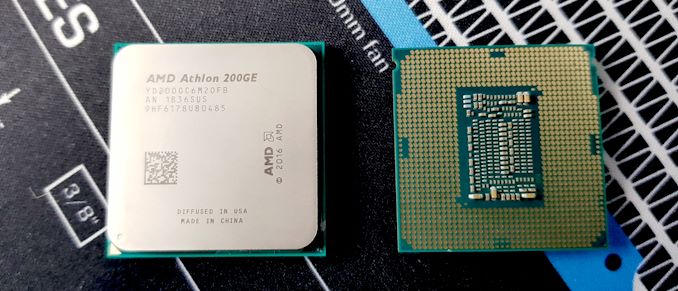The $60 CPU Question: AMD Athlon 200GE or Intel Pentium Gold G5400? A Review
by Ian Cutress on January 14, 2019 8:00 AM EST
In the course of our reviews, when we get a chance to get hands on with random processors, we run our test suite and add the data to our database. Sometimes that doesn’t materialize directly into a review, but at least we have the data. Two very similar CPUs have come across my desk recently: AMD’s dual core Athlon 200GE, and Intel’s Pentium G5400. Both chips round to the $60 mark, have some form of integrated graphics, and are aimed at budget systems.
This is going to be fun
One of the perennial issues with modern technology review cycles is that there’s a lot of focus on the high-end parts. These are the ones that the manufacturers sample: they have the highest margins, but are also the halo products: if they sit atop of the standings, then the hope is that that influence will trickle down into the rest of the product range, typically the high-volume parts. There is also the added benefit that more people want to hear about the best of the best. It’s a reason why there are so many Ferrari and Aston Martin ‘WOW’ pieces in written and video media.
Normally this would make sampling very difficult. If we were reviewing cars, anyway. The two chips in today’s analysis, the Intel Pentium Gold G5400 and the AMD Athlon 200GE, cost around $60 apiece, which I forked out for personally as I was never expecting to be sampled. (AMD asked if I wanted a 200GE sample two days after my retail unit arrived, go figure. I sent that on to Gavin for his 7-year old’s new gaming system.)
| AMD vs Intel at ~$60 | ||
| AMD Athlon 200GE |
Intel Pentium Gold G5400 |
|
| Cores / Threads | 2 / 4 | 2 / 4 |
| Microarchitecture | Zen | Coffee Lake |
| Motherboards | X470, X370, B450 B350, A320, A300 |
Z390, Z370, Q370 H370, B360, H310 |
| CPU Frequency | 3.2 GHz | 3.7 GHz |
| L2 Cache | 512 KB/core | 256 KB/core |
| L3 Cache | 2 MB / core | 2 MB / core |
| Integrated Graphics | Vega 3 192 SPs |
UHD 610 12 EUs (96 ALUs) |
| DDR4 Support | DDR4-2933 | DDR4-2666 |
| GPU Frequency | Up to 1000 MHz | 350-1050 MHz |
| TDP | 35 W | 54 W (2-core die version) 58 W (4-core die version)* |
| Price | $55 (SRP) | $64 (1k/u) |
| * Intel harvests both 2+2 and 4+2 dies to make G5400 parts. It's impossible to know which one you have without removing the lid and measuring the die area. | ||
When we stack up the two processors side by side, it gets interesting. Both are dual core, quad thread parts. The Intel processor has the frequency advantage, running at 3.7 GHz compared to the 3.2 GHz of AMD, but the AMD has beefier Vega 3 integrated graphics compared to the UHD 610 (GT1) graphics of the Intel chip. One sore point might be the TDP, where the AMD chip has a rating of 35W and the Intel chip is rated at 58W, however as we’ll see in the review, neither of them come close to those values.
Tackling the budget end of the market is fun. I’ve been a long-time advocate for budget builders to build a system piece-by-piece, getting one high-end part at a time rather than smearing a budget across several average parts at once. Under this philosophy, these processors could very well be the start of one of those builds, only costing an average of $60 MSRP. Note that under this philosophy, you might end up with that big graphics card before a processor that can power it. We’re covering those benchmarks as well.
Before you click further, place your bets on who you think will win: the Intel Pentium Gold G5400, or the AMD Athlon 200GE?
Latest News: While neither processor is officially overclockable, since we tested for this article it was recently reported that MSI motherboards with certain BIOS versions will allow users to overclock the 200GE to ~3.9 GHz. I've asked Gavin to contribute, and he managed a nice 3.9 GHz over the 3.2 GHz base clock. Head over to page 21 for the details.
Pages In This Review
- Analysis and Competition
- Test Bed and Setup
- 2018 and 2019 Benchmark Suite
- CPU Performance: System Tests
- CPU Performance: Rendering Tests
- CPU Performance: Office Tests
- CPU Performance: Encoding Tests
- CPU Performance: Legacy Tests
- Gaming: Integrated Graphics
- Gaming: World of Tanks enCore
- Gaming: Final Fantasy XV
- Gaming: Shadow of War
- Gaming: Civilization 6
- Gaming: Ashes Classic
- Gaming: Strange Brigade
- Gaming: Grand Theft Auto V
- Gaming: Far Cry 5
- Gaming: Shadow of the Tomb Raider
- Gaming: F1 2018
- Power Consumption
- Overclocking
- Conclusions and Final Words











95 Comments
View All Comments
shabby - Tuesday, January 15, 2019 - link
Lol this chip hasn't been $60 for half a year, what was AT thinking writing this article? The intel bias is strong here.yannigr2 - Monday, January 14, 2019 - link
I stopped reading this article when I saw that the Pentium price is NOT based on the ACTUAL price of the processor in the market, but just some marketing/wishful thinking that Intel posts on it's site.Pity. I was expecting more from Anandtech.
mobutu - Monday, January 14, 2019 - link
"In gaming with a discrete graphics card, for example, if you've invested in something like the GTX 1080..."so we're talking about the absolute cheapest of the cheap build but all of the sudden "you invested in a GTX 1080" ?
megaLOL wtf is this
sing_electric - Monday, January 14, 2019 - link
Yeah, that sentence is weird (though I guess, if you have $400 now, you can get a working system with a very solid PSU and the rest of the specs listed here, and if you have money later, plop in a dGPU you actually want, and after that, get the CPU you actually want), but the reason to use a GTX 1080 in the test is that you can be more or less guaranteed that none of the scores you saw were GPU-bound, so you're getting an idea of CPU performance. Otherwise, whatever GPU they chose (1030? 1050? RX 550/560?) would sometimes be the bottleneck, meaning the charts wouldn't tell you anything comparing the two CPUs.drexnx - Monday, January 14, 2019 - link
I think the obvious conclusion from this article is skip both and buy the R3 2200Gshabby - Monday, January 14, 2019 - link
That cpu is still cheaper than the g5400 which costs $130 even at Newegg. Where did Ian get the price of the g5400? It makes this article worthless.sing_electric - Monday, January 14, 2019 - link
Right, I think these processors are aimed more at OEMs trying to hit a price point. The cheapest I can do a reasonable system build around these is $305, in which case, the extra cash to go for the R3 seems like a no-brainer.Even if its an upgrade vs. a new build, you're looking at ~$180 minimum ($60 for the CPU, $60 for the motherboard, since there is basically no way you already AM4/LGA1151 system and look at this as an "upgrade," and that means you probably need new RAM since chances are you're coming from DDR3), in which case, why not spend the extra $30-40 for a significant step up in processor (and, in the case of AMD, one that officially supports overclocking).
piasabird - Monday, January 14, 2019 - link
I would have thrown in the Intel i3 8100 quad core which is selling for $118 on Newegg. It is close to the same price as the i3 7100. If you purchase it at a Micro Center you might get $30 off on a motherboard combo.drzzz - Monday, January 14, 2019 - link
WTF Ian? As of this post the Intel is 183$ follow the link in the article and the AMD is 60$. This is not a even close to comparing 60$ parts. Seriously how did this get by the editors?shabby - Monday, January 14, 2019 - link
The editors were intel...